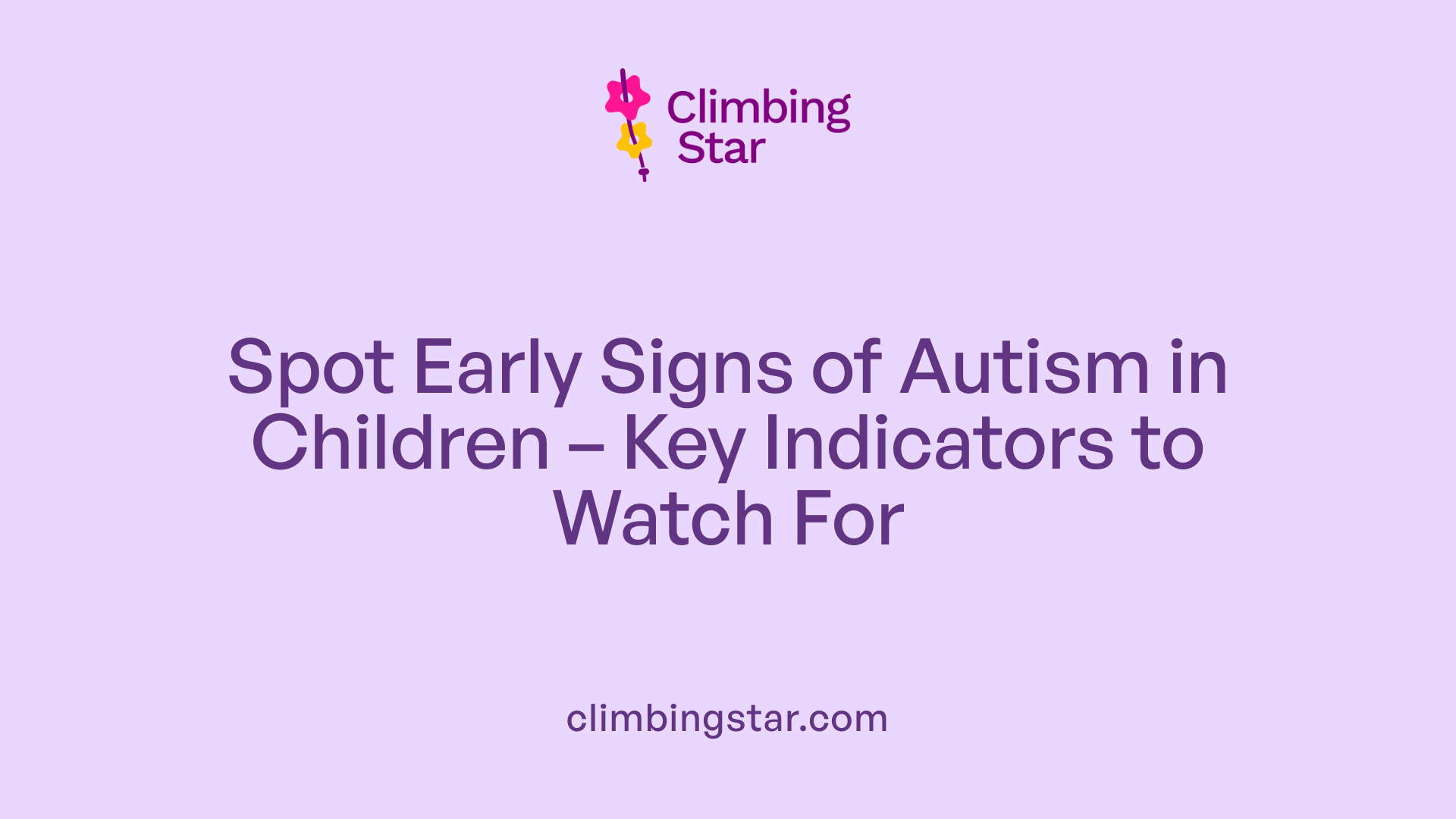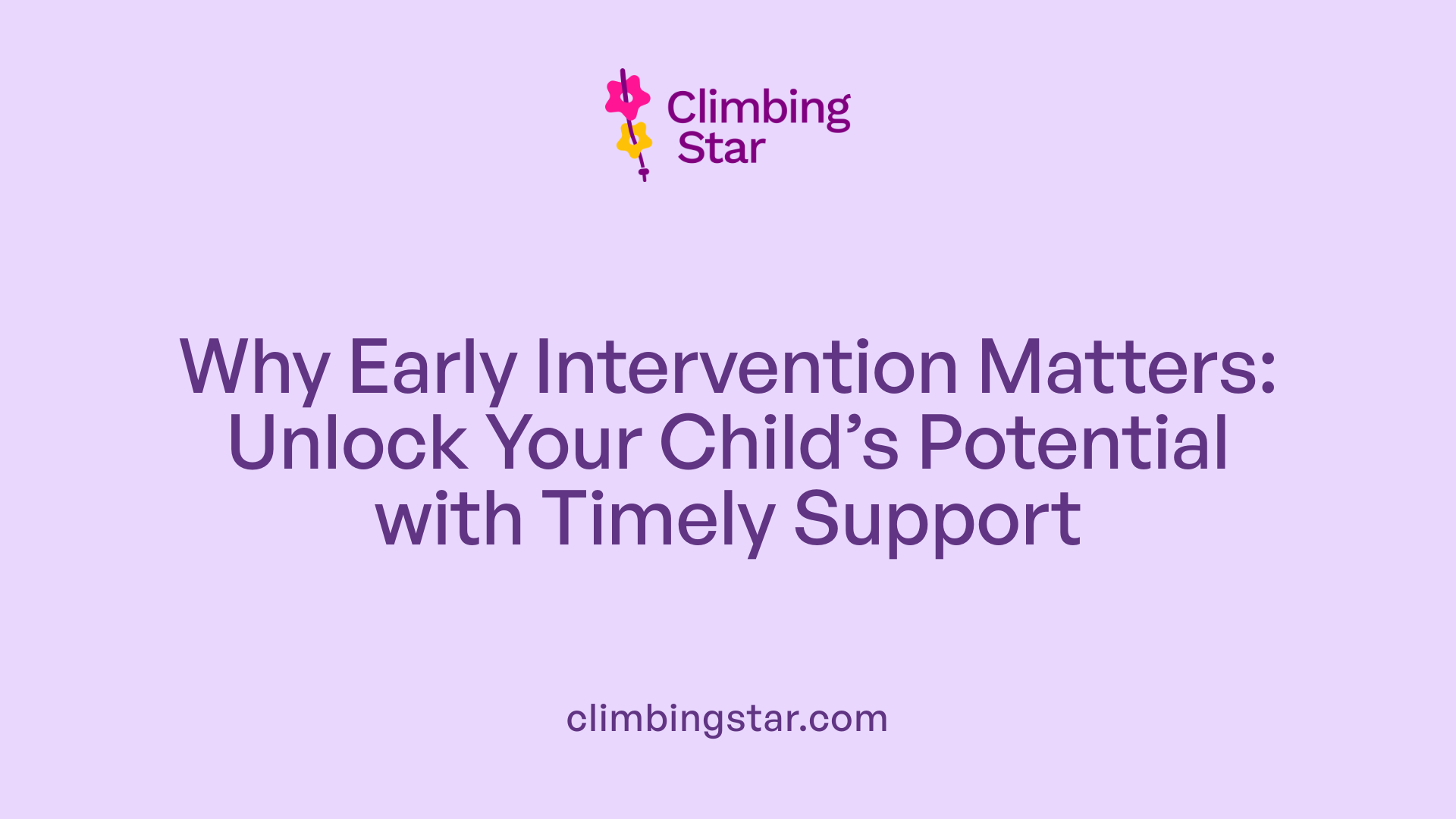Understanding the Early Indicators of Autism Spectrum Disorder
Autism Spectrum Disorder (ASD) is a complex developmental condition affecting communication, behavior, and social interaction. Recognizing the early signs can be challenging but is crucial for timely intervention and improved outcomes. This article explores how to identify autism in children, the diagnostic process, and the therapies available to support those affected, empowering families with knowledge and resources.
Identifying Early Signs of Autism in Young Children

Early Behavioral Signs
Young children with autism often show early signs that include limited or absent response to their name and reduced sharing of interests, such as pointing or showing objects to others. They may also demonstrate less frequent smiling and limited eye contact, which are crucial social cues typically seen by 12 to 18 months of age.
Communication Difficulties
Communication challenges may become noticeable early on, manifesting as delayed first words, lack of spontaneous babbling (like "gaga" or "baba"), and limited use of gestures such as waving or pointing. Some children exhibit scripted speech or echolalia, where they repeat words or phrases without typical conversational context.
Sensory Sensitivities
Many young children with autism show unusual responses to sensory input. This may involve strong reactions to certain tastes, sounds, or smells that upset them, or alternatively, a high tolerance or indifference to sensory stimuli. These sensory sensitivities can affect their everyday comfort and behavior.
Repetitive Behaviors
Repetitive movements are common, such as hand flapping, rocking, spinning, or other self-stimulating actions. These behaviors often serve as calming activities for the child but may interfere with other developmental milestones.
Social Interaction Deficits
Deficits in social interaction include difficulties with joint attention—a shared focus on an object or event—and reduced interest in social play. Children may struggle to imitate others’ actions or facial expressions and often do not seek to share enjoyment or interests spontaneously.
Recognizing these early signs through ongoing surveillance and screening, typically conducted at 9, 18, and 24 months during pediatric visits, enables timely referral for diagnostic evaluation. Early detection and intervention have been shown to significantly improve developmental outcomes for children with autism.
How Autism Manifests Differently Across Ages

Symptoms in Toddlers
In toddlers, early warning signs of autism often include limited or no response to their name, reduced eye contact, and a lack of smiling when smiled at. They may exhibit repetitive movements such as hand flapping or rocking. Speech delays are common, with some showing little to no babbling or limited use of words. Additionally, toddlers might show limited joint attention, meaning they rarely point to objects to share interest or respond to gaze shifts. Difficulty with pretend play and imitation can also be early indicators.
Signs in Older Children
As children grow, signs of autism can become more distinct. Older children might struggle to understand others' thoughts and feelings, leading to challenges in social situations. Speech may include unusual patterns such as echolalia (repetition of phrases) and talking at others without reciprocal communication. They often prefer strict routines and may develop intense interests in specific areas. Difficulties with emotions and making friends are frequent, with some children preferring solitude. Understanding social cues like sarcasm or body language also becomes a challenge.
Adolescent Challenges
In adolescence, social and emotional difficulties often become more apparent. Teens with autism may take things very literally and have trouble expressing their own feelings. Navigating complex social rules and building relationships can be challenging. Some adolescents may mask their difficulties by mimicking peers, making signs harder to detect, especially in girls. Intense interests and adherence to routines often remain, sometimes intensifying.
Social and Emotional Difficulties
Across all age groups, central to autism are differences in social communication and interaction. These include trouble with social-emotional reciprocity, understanding nonverbal cues such as facial expressions or body language, and building or maintaining relationships. Emotional regulation can also be difficult, contributing to challenges like tantrums or withdrawal.
Speech and Language Differences
Communication differences vary by age. Young children may have delayed speech or use scripted, repetitive language. Older children and adolescents might struggle with starting or sustaining conversations and exhibit unusual speech intonation. Echolalia is common, as is difficulty using language contextually. These challenges impact both verbal and nonverbal communication abilities, affecting social engagement and relationship building.
Recognizing Autism in Girls: Why Detection Can Be Harder
Masking behaviors
Girls with autism often engage in masking behaviors, where they consciously or unconsciously imitate their peers to conceal their difficulties. This camouflaging can make their challenges less apparent to parents, teachers, and clinicians, contributing to delayed or missed diagnosis.
Social coping strategies
Compared to boys, autistic girls may develop more sophisticated social coping strategies. They might withdraw from overwhelming situations instead of displaying overt distress or disruptive behaviors, which can further obscure their autism symptoms.
Fewer repetitive behaviors
Girls with autism tend to show fewer classic repetitive behaviors like hand-flapping or rocking. This difference in presentation means key signs that often prompt evaluation in boys might be less visible or less intense in girls.
Gender differences in autism presentation
Overall, autism manifests differently in girls and boys. Girls may demonstrate stronger social imitation and better eye contact, making their social communication difficulties less obvious. These gender differences impact how autism is detected, often requiring more nuanced observation and assessment to recognize subtle signs in girls.
Diagnostic Process: Screening and Criteria for Autism
How is developmental screening conducted for autism?
Developmental screening for autism is a crucial early step in identifying children who may need further evaluation. It typically involves monitoring and screening at key pediatric checkups, specifically at 9, 18, and between 24 to 30 months of age. During these visits, pediatricians observe social interactions, communication, play, and behavioral patterns to detect warning signs such as limited eye contact, lack of response to their name, or repetitive movements. Early identification allows timely referral to specialists for comprehensive assessment.
What role does the DSM-5-TR criteria play in diagnosing autism?
The Diagnostic and Statistical Manual of Mental Disorders, Fifth Edition, Text Revision (DSM-5-TR) provides the standardized criteria used to diagnose Autism Spectrum Disorder (ASD). A diagnosis requires persistent deficits in social communication and social interaction across multiple contexts. These include challenges with social-emotional reciprocity, nonverbal communication, and developing and maintaining relationships. Additionally, individuals must exhibit at least two types of restricted, repetitive behaviors or interests, such as stereotyped movements, insistence on sameness, or sensory sensitivities. Symptoms must be evident in the early developmental period and cause significant impairment.
What assessment methods are used beyond screening?
Following initial screening, detailed assessments by specialists involve comprehensive observations and interviews to confirm the diagnosis. These assessments evaluate communication skills, social behavior, and repetitive patterns based on DSM-5-TR guidelines. Though there are no specific laboratory tests for autism, genetic testing may be considered to explore potential causes. The goal is to gather a full developmental profile to tailor support and intervention strategies effectively.
Why is early diagnosis important?
Early diagnosis of autism is essential because it enables early intervention, which can significantly improve developmental outcomes. Children identified before age 3 can benefit from therapies such as Applied Behavior Analysis (ABA), speech therapy, and cognitive behavioral therapy (CBT), which promote social skills, communication, and behavior management. Recognizing signs early also helps families access resources sooner, facilitating better support systems.
What is the role of pediatricians in autism diagnosis?
Pediatricians play a pivotal role in ongoing developmental surveillance, screening, and guiding families. They are often the first to notice atypical development through regular checkups and developmental milestone monitoring. Pediatricians recommend formal evaluations when screening indicates potential concerns and help coordinate care with specialists. Their involvement ensures continuous tracking of the child's progress and timely intervention referrals.
Core Characteristics of Autism Spectrum Disorder
What Are the Social Communication Challenges in Autism?
Autism Spectrum Disorder (ASD) primarily involves differences in social communication and interaction. Individuals with ASD may exhibit limited or delayed speech, use unusual speech patterns like echolalia (repeating phrases), and have difficulties with conversation skills such as starting or maintaining dialogues. They often avoid eye contact and show fewer facial expressions or gestures, which can make it challenging to understand others' emotions or body language. Difficulties also include interpreting social cues and participating in reciprocal social interactions, such as turn-taking in conversations.
What Are the Restricted and Repetitive Behaviors Seen in Autism?
Restricted and repetitive behaviors (RRBs) are a hallmark of ASD. These behaviors include repetitive movements like hand flapping, rocking, or spinning. Individuals often have a strong preference for routines and can become distressed when these routines change. They may develop intense interests in narrow topics and engage in repetitive play or activities that provide comfort and sensory input.
How Do Sensory Processing Differences Manifest in Autism?
Many people with autism experience sensory processing differences, which can include hypersensitivity or hyposensitivity to stimuli such as sounds, lights, smells, or touch. For example, loud noises or certain textures might cause discomfort or distress, while some may seek out strong sensory input. These sensory challenges affect daily functioning and contribute to behavioral responses.
What Emotional and Social Difficulties Are Common?
Beyond communication challenges, individuals with ASD frequently face difficulties managing emotions and social relationships. They may struggle to understand others' thoughts and feelings, find it hard to make friends, or prefer solitude. Literal thinking can make humor or sarcasm difficult to grasp. Emotional regulation challenges also contribute to behaviors such as tantrums or withdrawal in stressful social settings.
| Core Feature | Description | Examples |
|---|---|---|
| Social Communication Challenges | Difficulty with speech, understanding social cues, eye contact | Limited gestures, echolalia, avoidance of eye contact |
| Restricted and Repetitive Behaviors | Repetitive movements, insistence on routines, narrow interests | Hand flapping, distress at change, intense hobbies |
| Sensory Processing Differences | Atypical responses to sensory input | Hypersensitivity to noise, seeking tactile input |
| Emotional and Social Difficulties | Challenges in emotion regulation, understanding others | Difficulty making friends, literal interpretation |
Applied Behavior Analysis (ABA): An Effective Therapy for Autism
What is Applied Behavior Analysis (ABA) therapy, and how is it used to support individuals with autism?
Applied Behavior Analysis (ABA) therapy is a science-based approach that focuses on improving specific skills and reducing problematic behaviors by using applied behavioral principles. These principles involve analyzing the relationship between a behavior and its environment, often using the ABC model—Antecedents (what happens before a behavior), Behaviors, and Consequences (what happens after).
ABA is tailored to each individual's needs and strengths. Qualified professionals, such as Board Certified Behavior Analysts (BCBAs), design and oversee the therapy programs. It includes structured techniques like Discrete Trial Training (DTT), which breaks down skills into small, manageable steps, and naturalistic teaching, which embeds learning in everyday activities.
Principles of ABA
- Positive Reinforcement: Encouraging desired behaviors by rewarding them.
- Prompting and Fading: Supporting the individual to perform a behavior and gradually reducing help.
- Data Collection: Monitoring progress through systematic measurement.
Techniques used in ABA
- Discrete Trial Training (DTT): A structured teaching method that uses clear instructions and rewards.
- Natural Environment Teaching (NET): Learning skills in everyday settings.
- Modeling: Demonstrating behaviors that the individual can imitate.
Therapy Goals
The goals of ABA therapy include:
- Enhancing communication abilities, such as spoken language and nonverbal cues.
- Improving social skills, like turn-taking and eye contact.
- Developing daily living skills, such as dressing and eating.
- Reducing behaviors that interfere with learning or social interaction.
Research Support
ABA therapy is widely supported by research as an effective intervention for autism, especially when started early and delivered intensively. Studies show it can lead to significant developmental improvements, helping children with autism gain skills that foster independence and meaningful social engagement.
ABA's individualized, evidence-based approach makes it one of the most effective therapies to support individuals with autism throughout their development.
Who Provides Autism and Behavioral Analysis Therapy?
Who typically provides autism and behavioral analysis therapy?
Autism and behavioral analysis therapies are usually delivered by trained and qualified professionals dedicated to supporting children with Autism Spectrum Disorder (ASD). The primary providers include Board Certified Behavior Analysts (BCBAs), psychologists, and autism behavior specialists who develop and oversee tailored treatment plans.
ABA therapists or Registered Behavior Technicians (RBTs) implement therapeutic interventions based on the guidance from BCBAs. Additionally, speech therapists and occupational therapists may be involved to address communication and sensory challenges.
What are the roles of BCBAs, therapists, and specialists?
BCBAs are responsible for evaluating the child's needs, designing individualized programs, and supervising therapy sessions. Speech and occupational therapists focus on improving communication skills and sensory processing. Together with autism behavior specialists, these professionals form a collaborative team to address the child's unique requirements.
In what settings are these therapies provided?
Services are offered in various environments such as clinics, schools, and the child's home. This flexibility allows therapy to be integrated into the child's daily life, enhancing learning and generalization of skills.
How do professionals collaborate with families?
Families play a critical role in successful treatment. Specialists work closely with caregivers, providing training, regular progress updates, and adapting interventions to align with family goals and home routines.
How can families access these services?
Accessing autism and behavioral analysis therapy often begins with referrals from pediatricians or healthcare providers. Insurance coverage and local service availability influence options. Families may find qualified providers through professional directories, clinics, or community resources.
| Provider Type | Role | Typical Setting |
|---|---|---|
| Board Certified Behavior Analyst (BCBA) | Designs and supervises treatment plans | Clinics, schools, homes |
| Registered Behavior Technician (RBT) | Implements ABA interventions | Clinics, homes |
| Speech Therapist | Supports communication skills | Clinics, schools |
| Occupational Therapist | Addresses sensory and motor challenges | Clinics, homes |
| Autism Behavior Specialist | Provides specialized autism support | Multiple settings |
This team-based approach ensures that therapy is comprehensive, tailored, and supportive, enhancing outcomes for children with autism.
Key Benefits and Outcomes of Behavioral Analysis Therapies
Communication Improvement
Behavioral analysis therapies, especially Applied Behavior Analysis (ABA), are highly effective in enhancing communication skills for individuals with autism. These therapies focus on developing both verbal and nonverbal communication, helping children express their needs and interact more effectively with others.
Social Skill Development
These therapies teach social interaction skills such as turn-taking, understanding social cues, and building friendships. By practicing these skills in structured and natural settings, children learn to navigate social situations with greater confidence.
Daily Living Skills
ABA and related therapies help individuals develop essential daily living skills, including self-care, grooming, and academic tasks. Teaching these functional skills promotes independence and improves quality of life.
Importance of Early Intervention
Starting behavioral interventions as early as 12 to 18 months leads to the most favorable outcomes. Early and intensive therapy harnesses the brain’s plasticity during critical developmental periods and prevents challenges from becoming more entrenched.
Increased Independence
Over time, these therapies support individuals in performing tasks independently, reducing reliance on caregivers. This increased autonomy helps build self-esteem and prepares individuals for more complex life challenges.
Emotional Regulation
Behavioral analysis therapies also focus on managing emotions by teaching coping strategies and reducing behaviors that interfere with learning and socialization. Improved emotional regulation results in fewer tantrums and better adaptability to change.
Overall, behavioral analysis therapies are customized to each person's unique strengths and needs. They use evidence-based techniques like positive reinforcement and natural environment training to guide learning. This tailored approach leads to meaningful improvements in communication, social skills, independence, and emotional well-being for people with autism.
How Families and Caregivers Can Support Behavioral Therapy

How can families and caregivers support someone undergoing autism behavioral therapy?
Families and caregivers play an essential role in the success of behavioral therapy for individuals with autism. Their active participation in therapy sessions creates a consistent learning environment that reinforces newly acquired skills. By learning and applying strategies taught by therapists, such as positive reinforcement and communication modeling, caregivers help generalize these skills beyond the clinical setting.
Creating structured routines at home is another important aspect. Predictable daily schedules reduce anxiety and provide a supportive framework for children to thrive. Additionally, caregivers can engage in caregiver-mediated interventions like Project ImPACT or JASPER, which focus on enhancing social engagement, joint attention, and communication skills. These programs empower families to be active partners in therapy.
Open communication with therapists ensures that caregivers understand therapeutic goals, share observations, and receive guidance tailored to the child's evolving needs. This collaboration supports consistent and effective intervention across different environments.
Caring for a child with autism can be demanding, so managing caregiver stress is crucial. Accessing resources such as support groups or stress-reduction techniques helps maintain caregivers’ emotional well-being, enhancing their ability to provide ongoing support.
Additionally, technology and telehealth services are valuable tools for continuous learning and assistance outside of formal therapy sessions.
Together, these approaches foster a nurturing and informed environment that significantly improves developmental outcomes for individuals with autism.
The Role of Pediatricians and Early Screening in Autism Detection
Developmental Monitoring and Screening Schedules
Pediatricians conduct developmental surveillance as an ongoing process during routine well-child visits. This involves tracking the child's progress in key areas such as social interaction, communication, and behavior.
Recommended Screening Ages
Formal autism screenings are recommended at specific ages: 9 months, 18 months, and 24 months or 30 months. These time points align with important social and communication developmental milestones.
Screening Tools Used by Pediatricians
Common screening tools include standardized questionnaires and checklists designed to detect early signs of autism. These tools assess behaviors like eye contact, response to name, joint attention, and the presence of repetitive movements.
Importance of Early Identification
Early detection through pediatric screening can lead to timely referrals and interventions. When autism is identified before age 3, therapies such as behavioral and speech interventions can begin, improving long-term outcomes.
Referral to Specialists
If a screening indicates possible autism, pediatricians refer children for detailed evaluation by specialists. This assessment includes diagnostic criteria based on the DSM-5-TR and may involve multidisciplinary teams.
By systematically monitoring development and screening at recommended intervals, pediatricians play a crucial role in early autism detection and ensuring children receive appropriate support as early as possible.
Sensory Sensitivities and Their Impact on Children with Autism

What Are Hypersensitivity and Hyposensitivity in Autism?
Children with autism often experience sensory processing differences, where their responses to sensory input are either heightened (hypersensitivity) or diminished (hyposensitivity). Hypersensitivity means a child may be extremely sensitive to certain stimuli like sounds, smells, or touch, reacting strongly or becoming distressed. Hyposensitivity, on the other hand, involves reduced sensitivity, where the child may seek out intense sensory input to compensate.
How Do Children with Autism React to Sounds, Smells, and Touch?
Many children with autism react strongly to everyday sensory experiences. For example, loud or sudden noises may cause distress or upset, while strong smells can be overwhelming. Some might find certain types of touch uncomfortable or even painful. These reactions can lead to avoidance of some environments or activities.
What Are Sensory Seeking Behaviors?
Some children with autism display sensory seeking behaviors, such as rocking, hand flapping, or spinning. These repetitive movements can serve as a way to self-regulate sensory input or provide comfort. Others might carry objects for long periods or seek out specific tactile experiences to satisfy sensory needs.
How Do Sensory Differences Affect Daily Life?
Sensory sensitivities can impact a child's participation in everyday activities, such as attending school, playing with peers, or even eating certain foods due to taste or texture issues. Difficulties managing sensory input may also contribute to emotional challenges and social withdrawal.
Strategies to Manage Sensory Issues
Families and caregivers can help manage sensory challenges by creating predictable routines and providing sensory-friendly environments. Occupational therapy often includes sensory integration techniques to help children regulate their responses. Using noise-canceling headphones, offering preferred tactile toys, or gradually introducing new sensory experiences can also be beneficial.
| Aspect | Description | Impact on Child |
|---|---|---|
| Hypersensitivity | Heightened sensitivity to sensory input such as loud sounds, smells, or touch | Avoidance, distress, tantrums |
| Hyposensitivity | Diminished sensory response leading to seeking intense stimuli | Repetitive movements, object carrying |
| Sensory Seeking Behaviors | Rocking, hand flapping, spinning to self-regulate | Helps self-soothe and manage sensory overload |
| Daily Life Impact | Challenges in school, social interactions, and eating preferences | Potential social isolation, emotional difficulties |
| Management Strategies | Occupational therapy, sensory-friendly spaces, gradual exposure | Improved coping and participation |
Understanding the Importance of Early Intervention for Autism

Why Start Therapy Before Age 3?
Early intervention for autism is crucial because symptoms often appear by 12 to 18 months of age, yet most children are diagnosed after age 3. Starting therapy before age 3 allows for support during a period when the brain is highly adaptable, increasing the potential for improving social, communication, and behavioral skills.
How Does Early Intervention Affect Long-Term Outcomes?
Early treatment can significantly enhance a child’s development, reducing challenges in social communication and repetitive behaviors. Children who receive early therapies often demonstrate better language skills, improved emotional regulation, and greater independence over time.
Types of Early Interventions
Several therapies are effective when started early, including:
- Applied Behavior Analysis (ABA): Focuses on skill-building and reducing challenging behaviors.
- Speech Therapy: Enhances communication and language abilities.
- Occupational Therapy: Helps children manage sensory sensitivities and develop everyday skills.
- Cognitive Behavioral Therapy (CBT): Addresses emotional and behavioral challenges.
Pediatricians usually guide families toward these services after developmental screening at 18 and 24 months.
Signs That Should Prompt Early Referral
Certain early signs—such as no response to name, lack of eye contact, limited gestures, repetitive movements, delayed speech, and minimal pretend play—warrant prompt evaluation. Observing these behaviors speeds up diagnosis and access to needed support.
Early awareness and intervention improve children’s quality of life, helping them achieve greater social connection and independence as they grow.
Empowering Families Through Awareness and Support
Recognizing whether a child has autism can be a complex and emotional journey for families. By understanding the varied signs that may appear from infancy through adolescence, families and caregivers can seek timely evaluations and appropriate interventions. Early screening by pediatricians and comprehensive diagnostic assessments help clarify the picture and guide families towards effective therapies such as Applied Behavior Analysis. With strong collaboration between professionals and families, alongside a commitment to ongoing support and tailored interventions, children with autism have the opportunity to develop essential skills, increase independence, and improve their quality of life. Awareness and education remain powerful tools in fostering understanding, acceptance, and meaningful progress for every child on the spectrum.
References
- Signs of autism in children
- Autism Spectrum Disorder (ASD) Symptoms & Causes
- Early Warning Signs of Autism Spectrum Disorder
- Signs that a child or adult may be autistic
- When do children usually show symptoms of autism? - NICHD
- Early Signs of Autism
- How Do I Know if My Child Has Autism?
- Autism spectrum disorder - Symptoms and causes







